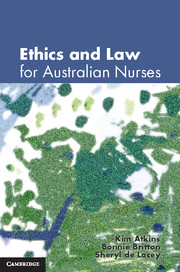Book contents
- Frontmatter
- Contents
- Introduction
- 1 Understanding the human person
- 2 Understanding legal rights and obligations
- 3 Nursing and the legal system
- 4 The nurse–patient relationship
- 5 Consent
- 6 Duty of care and professional negligence
- 7 Patient information, confidentiality and trust
- 8 ‘Trust me, I’m a nurse’
- 9 Witnessing and making mistakes
- Appendix: Tables of legislation
- References
- Index
4 - The nurse–patient relationship
- Frontmatter
- Contents
- Introduction
- 1 Understanding the human person
- 2 Understanding legal rights and obligations
- 3 Nursing and the legal system
- 4 The nurse–patient relationship
- 5 Consent
- 6 Duty of care and professional negligence
- 7 Patient information, confidentiality and trust
- 8 ‘Trust me, I’m a nurse’
- 9 Witnessing and making mistakes
- Appendix: Tables of legislation
- References
- Index
Summary
LEARNING OBJECTIVES
In this chapter, you will:
Gain an understanding of the nurse's power in the nurse–patient relationship
Learn about the fiduciary nature of the nurse–patient relationship
Gain an understanding of the legal and moral responsibilities of the fiduciary relationship
Develop your understanding of how to foster a therapeutic relationship with your patients
Develop your ability to identify risks in the nurse–patient relationship
Christine is a patient in the medical ward where you are working. She is anxiously awaiting some test results. You notice that she asks your fellow nurse, Carole, to call the resident doctor for her because she wants to ask the doctor some questions about things that are bothering her. Carole agrees, but then goes to morning tea.
When you ask Carole why she hasn't called the doctor, Carole replies, ‘I could call the doctor but I know that she won't come until her regular round at 11.30 am. Christine will just have to wait. If she asks me again I’ll just say that the doctor is busy but will be here at 11.30 am. She isn't going to complain. She knows how busy these doctors are.’
The focus of this chapter is the moral aspects of the nurse–patient relationship. Some people might think Carole is treating Christine with disrespect by misleading and then avoiding her. Others might think Carole is just being realistic. After all, the doctor really is busy and will not be free until 11.30. In order to work out whether or not this is an appropriate way to treat a patient, you will need to have a good understanding of nurses’ responsibilities to their patients and the moral basis of those responsibilities.
In Chapter 2, we noted that rights and obligations are like two sides of the same coin. A legal right comes with a corresponding obligation, or duty. A right is a legal entitlement to do something, and an obligation is the constraint upon individuals’ behaviour that comes with that entitlement. However, the nurse–patient relationship involves more than legalities. As discussed in Chapter 1, interpersonal relationships involve moral values such as respect, beneficence and compassion.
- Type
- Chapter
- Information
- Ethics and Law for Australian Nurses , pp. 78 - 97Publisher: Cambridge University PressPrint publication year: 2011

